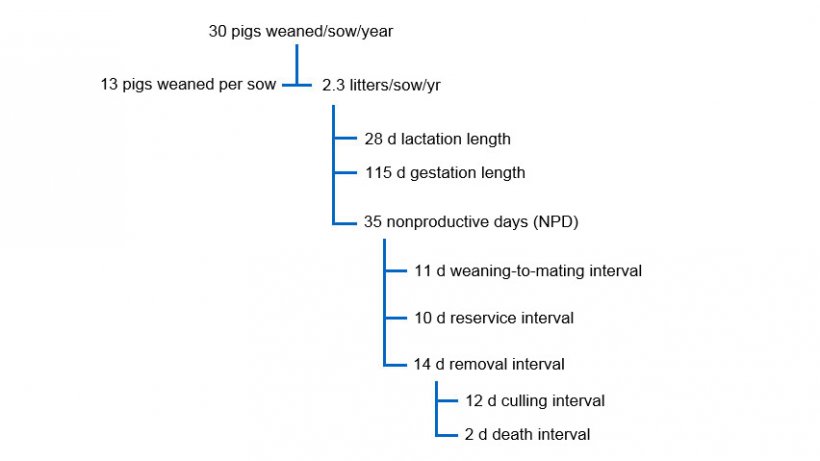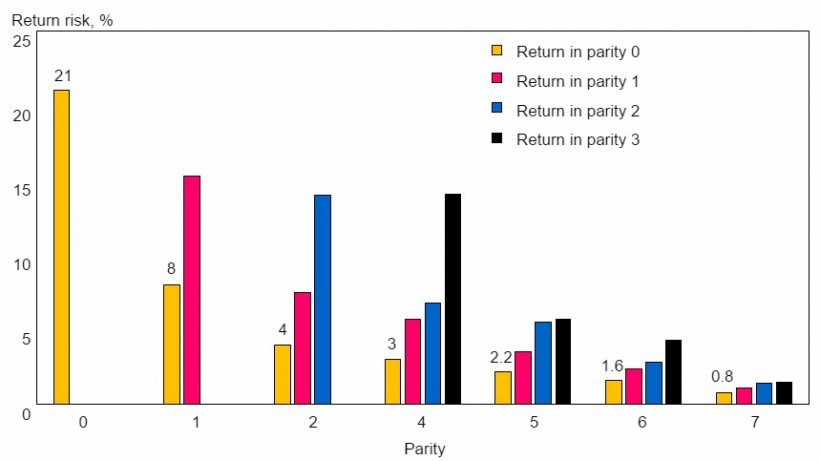The target for herd productivity is measured as the number of pigs weaned/sow/year (PSY), and this has recently increased to 30 pigs or higher. Sow prolificacy (e.g. pigs born alive) in modern genotypes is a major driver for increasing PSY. However, unlike the number of pigs born alive, a nonproductive sow day (NPD) is invisible to the naked eye, but this measurement is also a major contributing factor for PSY through the number of litters weaned/sow/year (LSY). This NPD is not related to genetic improvement but is instead a management tool used for measuring herd productivity in terms of PSY (Figure 1) and profitability. The NPD consists of weaning-to-first-service interval, reservice interval and removal interval.


Nonproductive sow days are estimated by the following formula, using the herd’s lactation length and gestation length:
NPD = 365 - [LSY x (lactation length + gestation length)]
The impact of NPD on PSY can be shown by looking at an average herd with 2,000 sows, 28 days lactation length, 60 NPD and 2.13 LSY, and which produces 11 pigs weaned/litter and 46,860 pigs /year. In this average herd, a reduction of 10 NPD will increase LSY to 2.20, and increase the total number of pigs weaned to 48,400 pigs. The net result is an additional 1,540 pigs and an improvement from 23.4 to 24.2 PSY. So, a decrease of one NPD is equivalent to an increase of 0.08 PSY.
There is another way to show the impact of NPD on PSY and pig values. It can be converted to the number of pigs weaned/sow/day. For example, if a herd has 30 PSY, then the farm produces 0.082 pigs/sow/day; the value of 0.082 pigs is calculated by dividing 30 PSY by 365 days. One weaned pig is likely to cost 30-50 USD, depending on the country and market, so an increase of one NPD per sow would cost 2.5-4.1 USD.
Weaning-to-first-mating interval (WMI) in NPD
Parity 1 sows have prolonged WMI. Also, WMI increases with higher outside temperatures. For example, our research has shown that an increase in high temperature from 25 to 35 °C increased WMI in parity 1 sows by 0.8 days, but in parities 2 or higher sows the increase in WMI was only 0.3 days. These results show that parity 1 sows are 2.7 times more sensitive to high temperature for WMI than sows in parity 2 or higher. This type of sensitivity in parity 1 sows is related to their low feed intake during lactation. Therefore, increasing feed intake in parity 1 sows, especially during summer, is a way to decrease WMI and NPD.
Reservice interval in NPD
Low farrowing rate increases both the reservice interval and culling interval. Reservice or culling is the consequence of an occurrence of reproductive failure such as return to estrus, abortion or fail-to-farrow.
About 10% of mated females have a return and are reserviced. Furthermore, our recent study showed that in lifetime, 33% of the first-returned females had a second return in the same or a later parity. For example, 21% of the first-returned gilts had a second return in the same parity 0, and another 20% had a second return in a later parity, from parity 1 to 6 or higher (Figure 2). These returned females had 42 more lifetime NPD than non-return females.

Removal interval in NPD
In another study, we categorized 100 herds into 3 groups based on the upper and lower 25th percentiles of PSY: high-, intermediate- and low-performing herds. In all the herd groups, actual culling intervals in mated gilts and any parity mated sows were at least 20 days higher than the culling guideline values. In the study, actual culling intervals for mated sows and gilts in parity 0 to 5 in low-performing herds were 14 days or higher than in high-performing herds. Therefore, it is important to make a guideline that is strictly followed in order to reduce the culling interval.
Another removal interval is the death interval. Approximately 10-15% of sows that are entered into breeding herds die. Any increase in mortality occurrences will increase NPD. Farrowing is a major risk factor for deaths in all parities and season. Approximately 68% of female deaths occur in a 6-week peripartum period, with an increased sow mortality risk as the number of parity increases. The highest risk of sow death is for parity 6 or higher sows in the peri-partum period during summer. Therefore, increased care in the peripartum period in the farrowing barns would decrease the number of sow and gilt deaths, as well as the death interval and NPD.
In conclusion, we recommend that producers pay more attention to gilts and sows that are at risk of increasing NPD.




